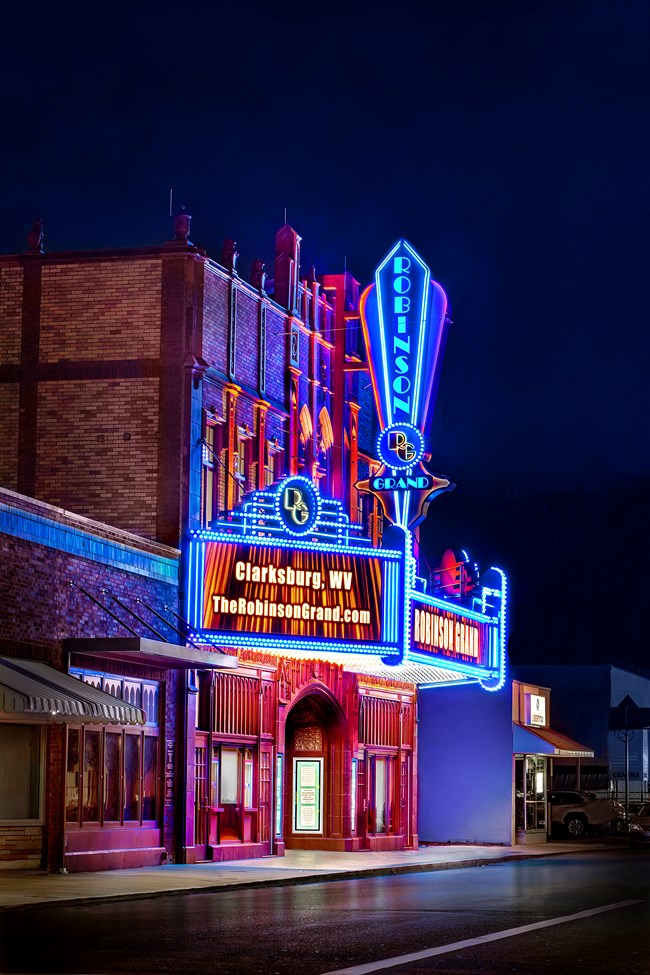Last updated: November 16, 2022
Article
Case Study: Robinson Theater, Clarksburg, West Virginia

Art by Crim

Joe McNemar Photographer, Stonewood, West Virginia
Building History
The Robinson Grand Theater was built by Clarksburg Amusement Company in 1912, opening its doors in 1913. The Robinson brothers, Claude and Rueben, ran the day-to-day operations. Part of the Keith-Albee vaudeville circuit, the theater hosted such famous performers as Jack Benny and ventriloquist Edgar Bergen. The theater was significantly enlarged and remodeled in 1927. Claude Robinson’s friendship with Albert Warner of Warner Brothers gave him early access to the new sound technology, and the theater became one of the first in the nation to show “talkies.” In May of 1939, a fire destroyed most of the stage and auditorium, leaving the front part of the building, including the façade, largely intact. The façade was retained and an entirely new auditorium and stage in the Streamline Moderne style designed by Edward J. Wood were added. The theater reopened in December 1939, less than seven months after the fire. The reopening, which the theater presented as its “Christmas gift to Clarksburg,” was lauded by the press, and received page upon page of congratulatory ads from the contractors and suppliers involved in the project. The interior was remodeled in 1984 to be more competitive with suburban multiplexes, but attendance continued to decline steadily until the theater closed in 2004.
The City of Clarksburg acquired the building in 2014 and immediately began a lengthy planning process to come up with a compatible reuse for the theater, which is a contributing structure to the Downtown Clarksburg National Register Historic District. A public-private partnership was created with the City, The Cultural Foundation of Harrison County, and others in the North Central West Virginia region to undertake the rehabilitation of the theater into a performing arts center. The project began in January 2017, and the Robinson Grand Performing Arts Center held its Grand Opening in October 2018.
Scope of Rehabilitation
The project restored the exterior, and the historic windows were repaired and retained. A new marquee with LED lighting and video display was installed. Inside, the historic chandeliers, terrazzo flooring, water fountains, and grand staircases in the lobby were preserved and repaired. The original coved plaster ceilings and antique air diffusers in the performance hall were preserved and updated with indirect lighting. The grand proscenium design was retained, along with the stage and ballroom flooring and decorative glass displays. In addition to making the building ADA compliant, the project included the construction of two additions containing a new concession area, expanded restrooms, and new green room/dressing rooms that connect directly to the stage. New drainage and an orchestra green room were installed in the basement. The rehabilitation resulted in a performance hall that seats over 1,000 patrons and an educational center with prep-kitchen and circular bar and lounge areas on the second floor.
Role of the Historic Tax Credit
The rehabilitation of the Robinson Grand Performing Arts Center would likely not have happened without the support of Federal Historic Tax Credits. Additionally, significant spaces like the lobby, ballroom, and performance hall could not have been brought back to their original luster. Other important incentives included West Virginia State Historic Tax Credits, Federal New Markets Tax Credits, and a capital campaign that raised nearly $2 million in private contributions.
Economic Impact on Community
The theater attracts over 120,000 visitors to 250 events a year and provides 11 free events to the local community. The impact of the performing arts center has been a catalyst for new economic development in the area. A new restaurant has opened several blocks from the theater, and an adjacent property has been recently purchased in preparation for new development to be completed in 2021. Increased local tax revenues can be attributed to increased foot traffic in and around the Robinson Grand Performing Arts Center.
Learn More
Fiscal Year 2019 Highlights and Reports
- Federal Tax Incentives for Rehabilitating Historic Buildings Annual Report for Fiscal Year 2019
- Annual Report on the Economic Impact of the Federal Historic Tax Credit for Fiscal Year 2019
Additional Case Studies
- Case Study: St. Rose de Lima Church Complex (New Orleans, Louisiana) The rehabilitation of this historic complex, including a church and two schools, provides new homes for a theater company, social justice organizations, dozens of micro-entrepreneurs, and a charter school. The tenants in the rehabilitated buildings and the services they provide created new jobs and draw visitors who have helped to revitalize the surrounding area.
- Case Study: Cambridge Apartments (Seattle, Washington) The historic rehabilitation of the Cambridge Apartments illustrates how historic preservation can meet the demand for affordable housing. The rehabilitated Cambridge Apartments provides affordable housing that is convenient to the city’s financial, government, hospital, and education job centers and serves households earning below 50% to 60% of area median income.
- Case Study: Hale Bathhouse (Hot Springs, Arkansas) The Hale Bathhouse is the oldest bathhouse on Bathhouse Row in Hot Springs National Park. Its rehabiliation into Hotel Hale was made possible with a long-term lease from the National Park Service.
